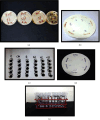Enhancing Presurgical Infant Orthopedic Appliances: Characterization, Mechanics, and Biofilm Inhibition of a Novel Chlorhexidine-Halloysite Nanotube-Modified PMMA
- PMID: 38962288
- PMCID: PMC11221949
- DOI: 10.1155/2024/6281972
Enhancing Presurgical Infant Orthopedic Appliances: Characterization, Mechanics, and Biofilm Inhibition of a Novel Chlorhexidine-Halloysite Nanotube-Modified PMMA
Abstract
Objectives: This in vitro study aimed to develop a novel nanocomposite acrylic resin with inherent antimicrobial properties. This study evaluated its effectiveness against microbial biofilm formation, while also assessing its physical and mechanical properties.
Methods: Polymethylmethacrylate (PMMA) was modified with four different concentrations of chlorhexidine halloysite nanotubes (CHX-HNTs): 1%, 1.5%, 3%, and 4.5 wt.% by weight, along with a control group (0 wt.% CHX-HNTs). The biofilm inhibition ability of the modified CHX-HNTs acrylic against Candida albicans, Staphylococcus aureus, Streptococcus pneumoniae, and Streptococcus agalactiae was assessed using microtiter biofilm test. In addition, ten samples from each group were then tested for flexural strength, surface roughness, and hardness. Statistical analysis was performed using one-way ANOVA and Tukey's test for comparison (P < 0.05).
Results: CHX-HNTs effectively reduced the adhesion of Candida albicans and bacteria to the PMMA in a dose-dependent manner. The higher the concentration of CHX-HNTs, the greater the reduction in microbial adhesion, with the highest concentration (4.5 wt.%) showing the most significant effect with inhibition rates ≥98%. The addition of CHX-HNTs at any tested concentration (1%, 1.5%, 3%, and 4.5 wt.%) did not cause any statistically significant difference in the flexural strength, surface roughness, or hardness of the PMMA compared to the control group.
Conclusions: The novel integration of CHX-HNT fillers shows promising results as an effective biofilm inhibitor on acrylic appliances. This new approach has the potential to successfully control infectious diseases without negatively affecting the mechanical properties of the acrylic resin. Clinical Relevance. The integration of CHX-HNTs into presurgical infant orthopedic appliances should be thoroughly assessed as a promising preventive measure to mitigate microbial infections. This evaluation holds significant potential for controlling infectious diseases among infants with cleft lip and palate, thereby offering a valuable contribution to their overall well-being.
Copyright © 2024 Nadia Al Ansari and Mushriq Abid.
Conflict of interest statement
The authors declare that they have no conflicts of interest.
Figures









Similar articles
-
Enhanced antimicrobial efficacy of chlorhexidine-encapsulated halloysite nanotubes incorporated in presurgical orthopedic appliances: an in vitro, controlled study.Clin Oral Investig. 2024 Jan 2;28(1):68. doi: 10.1007/s00784-023-05464-7. Clin Oral Investig. 2024. PMID: 38165480
-
Resin-based dental materials containing 3-aminopropyltriethoxysilane modified halloysite-clay nanotubes for extended drug delivery.Dent Mater. 2021 Mar;37(3):508-515. doi: 10.1016/j.dental.2020.12.011. Epub 2021 Jan 23. Dent Mater. 2021. PMID: 33500150
-
Evaluation of polymethyl methacrylate resin mechanical properties with incorporated halloysite nanotubes.J Adv Prosthodont. 2016 Jun;8(3):167-71. doi: 10.4047/jap.2016.8.3.167. Epub 2016 Jun 17. J Adv Prosthodont. 2016. PMID: 27350849 Free PMC article.
-
Microbiological, physicomechanical, and surface evaluation of an experimental self-curing acrylic resin containing halloysite nanotubes doped with chlorhexidine.Dent Mater. 2024 Feb;40(2):348-358. doi: 10.1016/j.dental.2023.12.003. Epub 2023 Dec 22. Dent Mater. 2024. PMID: 38142145
-
Modification of polymethylmethacrylate bone cement with halloysite clay nanotubes.BMC Oral Health. 2024 Aug 4;24(1):893. doi: 10.1186/s12903-024-04600-3. BMC Oral Health. 2024. PMID: 39098928 Free PMC article.
References
-
- McNEIL C. K. Orthodontic procedures in the treatment of congenital cleft palate. Dent Rec (London) . 1950;70(5):126–132. - PubMed
-
- Hosseini H. R., Kaklamanos E. G., Athanasiou A. E. Treatment outcomes of pre-surgical infant orthopedics in patients with non-syndromic cleft lip and/or palate: a systematic review and meta-analysis of randomized controlled trials. PLoS One . 2017;12(7) doi: 10.1371/journal.pone.0181768. - DOI - PMC - PubMed
-
- Mahmood S. D., Al-Mulla A. A. Incidence of cleft lip and palate in Al-ramadi city (descriptive epidemiological study) Journal of Baghdad College of Dentistry . 2016;28(2):139–144. doi: 10.12816/0028237. - DOI
LinkOut - more resources
Full Text Sources

